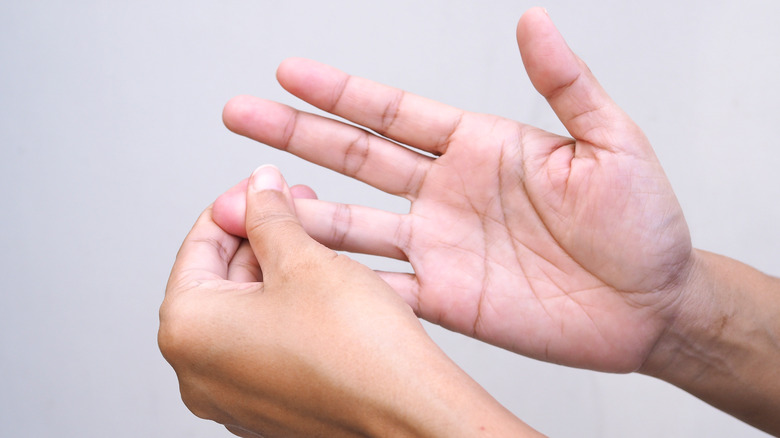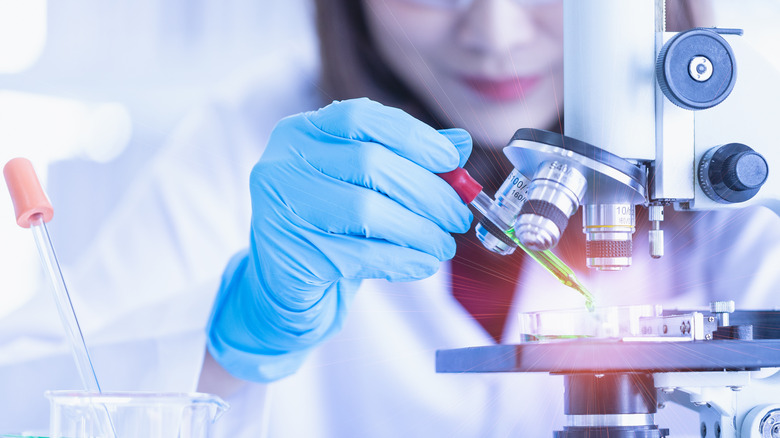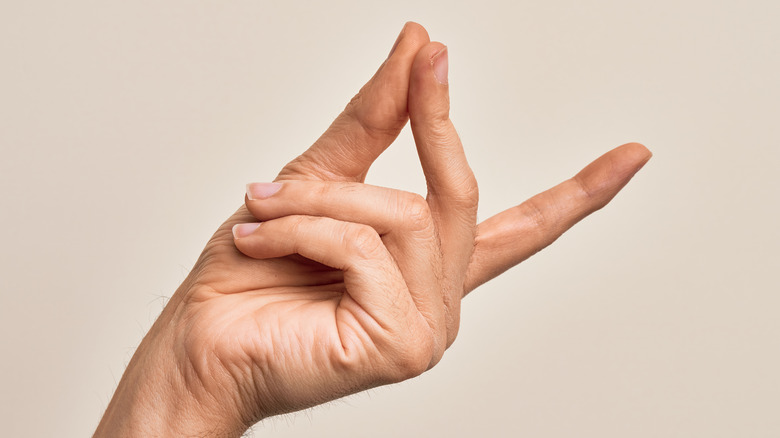The Science Behind How The Human Body Can Grow Back Fingertips
Plenty of creatures in the Earth's animal kingdom have astounding and incredible abilities. From heightened senses like smell and sight to surviving extreme environments, they adapt to the world around them in order to get by. By comparison, the human body might seem pretty boring. But humans have some surprising abilities of their own, including those that overlap with animals.
Certain species of reptiles and amphibians are famous for their ability to regenerate limbs like a tail or a leg. Some sea slugs can even survive decapitation. While all of that is a little beyond the human body, it might surprise you to learn that it is possible for a person to regrow at least part of a lost body part: the fingertip (per Nature). Under the right circumstances, a lost fingertip won't even need much medical attention to regenerate itself, according to NPR. But, how does it all work, and is it something everyone can do?
The younger you are, the better
Many of those looking into fingertip regeneration point to the same story. A young girl, either seven or eight years old, stuck her finger in the spokes of her brother's bike and lost the tip of her finger, as NPR notes. The family went to the doctor and, after some time spent examining the wound and searching for options, it was determined that the lost fingertip couldn't be reattached.
Doctors had a simple recommendation: Bandage up the wound and leave it alone. For the young girl in question, it worked. The doctor who worked on her case told NPR she returned sometime later with a fully regrown fingertip, "far better than anything [he] could have given her" through the procedures they might have done in the emergency room. It's something scientists believe is generally limited to children, whose bodies are more capable of producing the cells needed to regrow the bone, nerves, and skin.
The cells behind the science
Much like young kids, mice are known for their ability to regenerate claws and toes through the use of certain cells. According to Live Science researchers are looking to them for a better understanding of how it all works, and they've figured out it all starts with the nail. If a mouse's toe is removed but enough of the nail is left behind, regeneration can happen. Similarly, the regrowth of a human fingertip is only possible if some of the nail and the skin underneath are left behind, as NPR notes.
That's because the nailbed is host to some very important cells, something you've probably heard about: stem cells. Research into the regenerative properties of stem cells is ongoing for a whole host of different things, from cancer to cloning. It turns out, they also play an important role in how your hair and fingernails grow and can rework themselves into the shape of the lost fingertip.
A whole lot of nerve
There's another element at play beyond just age and fingernails, though. According to Live Science, research into mice's regenerative abilities show the nerves are just as important as the stem cells. These somewhat mysterious cells send the signal to regrow the mouse's missing claw, according to NPR, but the nerve's involvement is what allows bone to regrow and for the fingertip to be more than just skin. The whole process relies on abilities that fetuses rely on to grow limbs and body parts inside the womb.
Although this might sound like something out of a science fiction novel, there are plenty who point to its shortfalls. The growth of a fingertip is impressive, but it happens under such limited and specific circumstances that it's hard to know if we'll ever be able to get to the point of fully regrowing limbs. According to National Geographic, humans tend to grow scar tissue rather than starting the regenerative process, and it's not exactly clear what biological differences make us that way.
Emerging technology to help adults
When children lose a fingertip, the recommendation is to let it heal on its own. For adults, the situation is much more complicated and unreliable — but it's not necessarily a lost cause. According to CNN, even an adult who has lost a fingertip has the opportunity to get it back thanks to procedures aimed at tissue regeneration. In one specific case, a woman who lost the tip of her pinky finger was able to grow one back after the removal of scar tissue and the use of special powders.
The fingertips we grow back won't be the same as what we had. For the adult who regrew hers, it was smaller than what she'd had before. And even for children, the regrown fingertip won't have a fingerprint and it may not look the same (via NPR). But, for those who have managed to grow one back, those small differences don't seem to matter much in the face of a fully functional finger.




